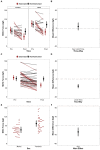Unilaterally Induced Quadriceps Fatigue during Sustained Submaximal Isometric Exercise Does Not Alter Contralateral Leg Extensor Performance
- PMID: 37367249
- PMCID: PMC10301249
- DOI: 10.3390/jfmk8020085
Unilaterally Induced Quadriceps Fatigue during Sustained Submaximal Isometric Exercise Does Not Alter Contralateral Leg Extensor Performance
Abstract
This study investigated the effects of fatiguing unilateral exercise on the ipsilateral, exercised, and contralateral, non-exercised limb's post-exercise performance in males and females. Ten males and ten females performed a fatiguing, unilateral isometric leg extension at 50% maximal voluntary isometric contraction (MVIC) force. Prior to and immediately after the fatiguing tasks, MVICs were performed for the exercised and non-exercised limb, with surface electromyographic (sEMG) and mechanomyography (sMMG) amplitude (AMP) and mean power frequency (MPF) recorded from each limb's vastus lateralis. There were no fatigue-induced, sex-dependent, differences in time to task failure (p = 0.265) or ipsilateral performance fatigability (p = 0.437). However, there was a limb by time interaction (p < 0.001) which indicated decreases in MVIC force of the ipsilateral, exercised (p < 0.001), but not the contralateral, non-exercised limb (p = 0.962). There were no sex-dependent, fatigue-induced differences in neurophysiological outcomes between the limbs (p > 0.05), but there was a fatigue-induced difference in sEMG MPF (p = 0.005). To summarize, there were no differences in fatigability between males and females. Moreover, there was insufficient evidence to support the presence of a general crossover effect following submaximal unilateral isometric exercise. However, independent of sex, the neurophysiological outcomes suggested that competing inputs from the nervous system may influence the performance of both limbs following unilateral fatigue.
Keywords: cross-over effects; non-localized muscle fatigue; performance fatigability.
Conflict of interest statement
The authors declare no conflict of interest.
Figures






Similar articles
-
No sex differences in time-to-task failure and neuromuscular patterns of response during submaximal, bilateral, isometric leg extensions.Eur J Appl Physiol. 2024 Oct;124(10):2993-3004. doi: 10.1007/s00421-024-05508-0. Epub 2024 May 21. Eur J Appl Physiol. 2024. PMID: 38772923
-
Examination of sex differences in fatigability and neuromuscular responses during continuous, maximal, isometric leg extension.Physiol Meas. 2024 Oct 8;45(10). doi: 10.1088/1361-6579/ad7fcd. Physiol Meas. 2024. PMID: 39322012
-
Effect of differing intensities of fatiguing dynamic contractions on contralateral homologous muscle performance.J Sports Sci Med. 2014 Dec 1;13(4):836-45. eCollection 2014 Dec. J Sports Sci Med. 2014. PMID: 25435777 Free PMC article.
-
Is the cross-over effect of a unilateral high-intensity leg extension influenced by the sex of the participants?Biol Sex Differ. 2018 Jun 28;9(1):29. doi: 10.1186/s13293-018-0188-4. Biol Sex Differ. 2018. PMID: 29954447 Free PMC article.
-
Sex differences in fatigability of dynamic contractions.Exp Physiol. 2016 Feb;101(2):250-5. doi: 10.1113/EP085370. Epub 2015 Nov 17. Exp Physiol. 2016. PMID: 26440505 Free PMC article. Review.
Cited by
-
Implementation and Feasibility of Mechanomyography in Minimally Invasive Spine Surgery.J Pers Med. 2025 Jan 23;15(2):42. doi: 10.3390/jpm15020042. J Pers Med. 2025. PMID: 39997319 Free PMC article.
-
Examination of Sex-Related Differences in Fatigability and Frequency Components of Mechanomyographic Signals During Sustained Exercise.Muscles. 2024 Dec 4;3(4):417-430. doi: 10.3390/muscles3040035. Muscles. 2024. PMID: 40757524 Free PMC article.
References
LinkOut - more resources
Full Text Sources
Miscellaneous

